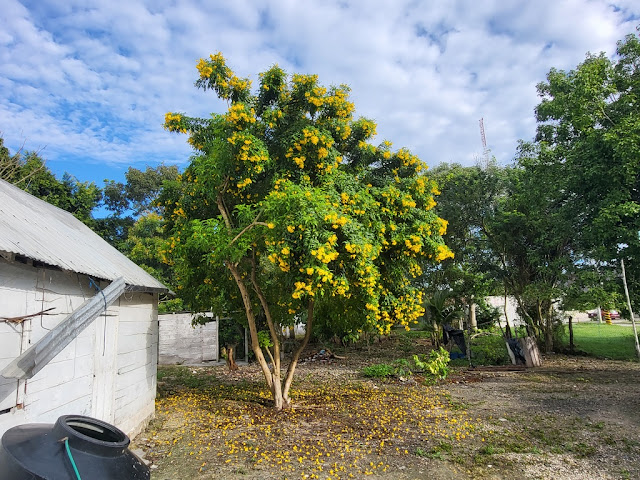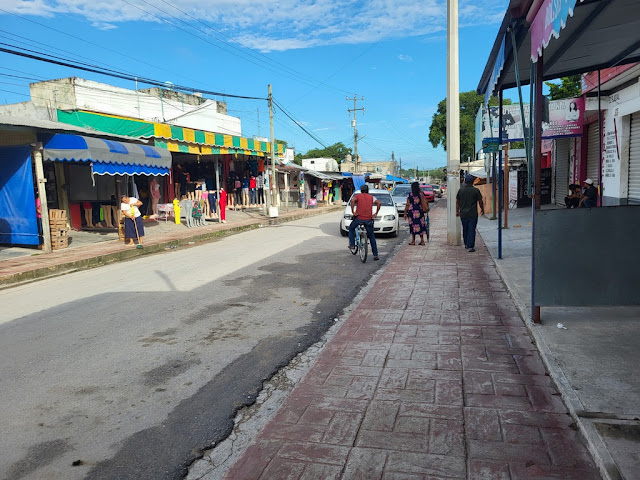Saturday evening, December 2
It's not quite 5:30, and the sun has
just set, the air mercifully cooled down after the day's blasting
heat. The smoke and smell of charcoal fires is all around, asados
fired up for the evening; trucks, cars, a few tuk-tuks –
the three-wheeled taxis that are part of the traffic in every small
town - and of course motorcycles rumble and rattle by constantly. “Quiet” is a foreign word in this town. Without our plan
to visit Calakmul we would have likely never come here, and now,
after a long day of bus travel yesterday and uncertainty how to get
from here to our next destination we hope very much that Calakmul
will be worth it. Unlike
Izamal and Ticul the town itself offers not a whole lot to endear it
to us, but it is, I believe, as genuinely Mexican as it can get.
After our stopover in Campeche, which seems worlds away, we took the 'Sur' bus at 1:30 in the afternoon. When we realized how many people were lined up already more than half an hour before departure time we quickly joined them: there are no assigned seats on this bus, and the thought of getting a standing-room only spot for the long trip did not appeal to us. Travel time was expected to be five hours, but of course those are only guidelines. No matter how long it would take, we'd arrive in the dark, and of course we had no idea what to expect in Xpujil.
For the first while the bus laboured up one hill after the other on a four-lane highway bordered by dense vegetation on both sides, until after a descent to match the climb we were again at sea level at the fishing village of Seybaplaya. Long rows of fishing boats with bunched-up nets were moored along the narrow beach, gulls, cormorants and many pelicans gathered on their gunwales. Dark herons and white egrets stood poised to snatch up fish, men stood and sat together in small groups, talking and laughing. The road followed the coast line for a good while until we turned off inland in Champotón. Now, we drove through an obviously fertile area. The corn fields from further north were replaced by wide expanses of sugarcane, interspersed with pastures filled with cow herds.
At
five we were in Escárcega,
another mid-sized town. The trip had taken three and a half hours
already, and looking at the map we saw no way that we'd be in Xpujil
in another two and a half. The next leg of the trip must have been
harrowing for the bus driver. Truck after truck loaded with rocks and
other building materials travelled in both directions, and to pass
one after the other on the now two-lane road in the dark with dense
oncoming traffic would be a nightmare. He managed, however, but it
didn't take us long to figure out that his information that it would
take another two hours from Escárcega
would never hold up. By 7:30 we wondered if we would ever make it,
but finally we started seeing signs with ruins along the highway.
Now, it could not be very far anymore. Still, it took another half
hour until we finally reached our destination. It's often a bit
unnerving to not know for sure when we are close, and there is always
a slight anxiety that we might miss the right stop. It's no problem
in towns with a terminal, even small, but depending on the size of
the town the stop could be on the side of the highway, and of course
neither sign nor driver necessarily alerts you to it. It's even worse
when we sit in the back of the bus like yesterday. I went up to the
driver twice to make sure he wouldn't forget us.Who knows, we might
be the only passengers getting off. This wasn't the case, however,
and a friendly young man who got off with us pointed out the taxi
stand to us, insisting it was a better idea than to walk the
kilometre or so to the Coa de Collar, our chosen quarters.
Sunday morning
This is how far I got last night until I was overcome by tiredness. It is now 6:15 in the morning. Just like yesterday morning dense fog makes it impossible to see further than the houses across the narrow street, and the rooster concert is in full swing. Around seven we'll be picked up by a collectivo that will take us to the Calakmul ruins and bring us back here in the afternoon. We'll have about three hours to explore the site.
There is a much smaller site, the Xpuhil archaeological zone, within walking distance, and after a walk through town in the morning to get a feel for our surroundings we chose this as our destination for Saturday afternoon. It was rediscovered in the 1930s, its yucatec Maya name referring to a kind of cattail that grows around the principal waterhole of the site.
Only a handful of people wandered the grounds, and if it hadn't been for the very noisy highway running right by it it would have been very peaceful indeed.
This highway is the one we arrived on, and the huge amounts of heavy traffic are mostly due to the construction of a very ambitious project, the 'Tren Maya', also known as the Maya Train. This is a 1,525 km railway that will traverse the Yucatán Peninsula. It will connect Palenque with Cancún via two routes that circle the entire peninsula. Construction began in June of 2020 and operation is scheduled to begin in the middle of this month. Judging by what we have seen here it is an enormous project, and of course it hasn't been without controversy. It undoubtedly will bring more people from the holiday places on the east coast here to this area, but it remains to be seen if it really has the hoped-for effect.
Here are a few impressions from our walk to the bus station in the morning. The last two pictures show the market area which is much more lively in the evening. The loudest section is around the place where people are gathered in front of a big TV screen to watch soccer games.














No comments:
Post a Comment